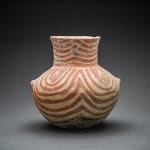Neolithic Painted Terracotta Vessel, 6000 BCE - 4000 BCE
Terracotta
20.3 x 21.6 cm
8 x 8 1/2 in
8 x 8 1/2 in
SF.229
Further images
Hacilar lived and died in prehistory. What remained of Hacilar became a mound on the plain and remained so until 1956. It was in this year that a local teacher...
Hacilar lived and died in prehistory. What remained of Hacilar became a mound on the plain and remained so until 1956. It was in this year that a local teacher showed the mound to British archaeologist James Mellaart. In 1957 the excavation of Hacilar began under Mellaart's direction and continued until 1960. The artifacts recovered during this excavation are currently on display at the Museum of Anatolian Civilizations in Ankara. Ceramics from Hacilar show similarities with those of the Halaf culture from about the same period. There are also similarities in their figurines. Stratigraphy[edit]
Up to 11 stratigraphic levels have been identified. The oldest strata belong to aceramic Neolithic, and are dated to the 8th millennium BC.[1] To the 6th millennium BC, nine levels are assigned, the oldest with ceramics, that were almost entirely undecorated. Level VI is dating back to 5600 BC, and there were many activities at this time. Nine buildings were found, grouped around a square. Livelihood mainly consisted of agriculture. Spelt, wheat, barley, peas and vetch were cultivated. Villagers engaged in the breeding of animals; bones of cattle, pigs, sheep, goats and dogs were found. The pottery is simple, although some specimens represent animals.[2] Numerous nude female figures, made of clay, are quite remarkable, and possibly represent some divinity. At level II (c. 5300 BC), the village was fortified and had a small temple. The settlement of level I, dating after 5000 BC, differs significantly from the previous layers, so it is believed that there were newcomers who settled here. The site is now heavily fortified. The pottery is of high quality and is generally painted in red on a cream background.
Up to 11 stratigraphic levels have been identified. The oldest strata belong to aceramic Neolithic, and are dated to the 8th millennium BC.[1] To the 6th millennium BC, nine levels are assigned, the oldest with ceramics, that were almost entirely undecorated. Level VI is dating back to 5600 BC, and there were many activities at this time. Nine buildings were found, grouped around a square. Livelihood mainly consisted of agriculture. Spelt, wheat, barley, peas and vetch were cultivated. Villagers engaged in the breeding of animals; bones of cattle, pigs, sheep, goats and dogs were found. The pottery is simple, although some specimens represent animals.[2] Numerous nude female figures, made of clay, are quite remarkable, and possibly represent some divinity. At level II (c. 5300 BC), the village was fortified and had a small temple. The settlement of level I, dating after 5000 BC, differs significantly from the previous layers, so it is believed that there were newcomers who settled here. The site is now heavily fortified. The pottery is of high quality and is generally painted in red on a cream background.







